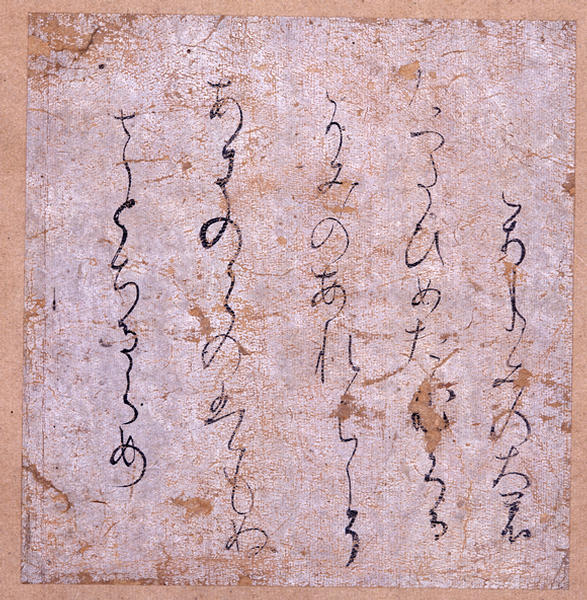Poems from Kokin wakashu, known as“Sunshoan Shikishi”
- attributed to Ki no Tsurayuki
- Heian period
- 11th century
- Hanging scroll, ink on decorated paper
- H-12.7 W-12.4
- Miho Museum
Catalogue Entry
"Sunshoan shikishi" is considered to be one of the three best calligraphy works executed on special paper stock called shikishi; the other two are "Tsugi shikishi" (attributed to Ono no Michikaze) and "Masu shikishi" (attributed to Fujiwara no Yukinari). For "Sunshoan shikishi", poems of the four seasons were selected from the Kokin wakashu, a collection of poetry dating to the early 10th century. The paper is imported from China it is made of bamboo fiber and colored with naturally obtained white pigment. Various designs were printed with mica or with a wax resist technique producing very rich opulent paper. These works of calligraphy, including the present work, do not conform to the standard shikishi shape of a rectangular piece of paper. They were not originally made into a piece of paper, but bound into a book by folding each sheet into two at the center, with the calligraphy side inside, stacking them, and gluing on the outside of the folds a method of binding called detchoso. They are called, nevertheless, "shikishi" in modern times because they had been handed down as pieces of paper like shikishi. "Sunshoan shikishi" was named after a place as a retreat called the Sunshoan that a well-known samurai, Sakuma Shokan Sanekatsu, built on the premises of the Ryokoin sub-temple in Daitokuji Temple, where he lived after retirement. Sakuma, who had served three generations of shoguns starting with Tokugawa Ieyasu, including the post of magistrate (bugyo), acquired twelve shikishi, all attributed to Ki no Tsurayuki, from Nanshuji Temple in Sakai, and enjoyed them at the Sunshoan in his last years.
The present piece is a free-form calligraphy of the poem by Kanemi no Okimi starting with the verse "Tatsutahime ..." (the 298th entry, in Volume Five of Kokin wakashu). Grasses design was probably printed with mica on a white background of the paper. The particular execution displays a remarkable balance of strength and elasticity resulting in a fluid yet elegant style. This is one of the reasons why "Sunshoan shikishi" represents a pinnacle of kohitsu (old, classic work of calligraphy) and graces many a tea room alcove along with "Tsugi shikishi."

